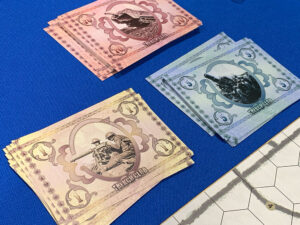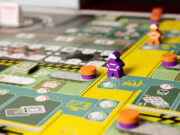 Wargames come in many shapes and sizes. At their core, the common elements position players as commanders of armed forces in conflict with one or more other commanders. Decisions can be tactical like moving individual units or strategic with army-level command. They also usually involve some sort of map with or without terrain.
Wargames come in many shapes and sizes. At their core, the common elements position players as commanders of armed forces in conflict with one or more other commanders. Decisions can be tactical like moving individual units or strategic with army-level command. They also usually involve some sort of map with or without terrain.
On the tactical side, games like Advanced Squad Leader (ASL) can lead players down a deep well of cardboard tokens while the more miniatures focused titles bring a deeper thematic integration with representations of individual units instead of the usual iconography of cardboard counters. Playability is another focus of some miniatures games. Here, the focus is on playability and getting dice to the table.
As it happens, new publisher PKB Games is aiming to bring tactical combat experience to the masses with Trench Club. The design goal is a tactical Miniatures wargame that is relatively easy to learn, featuring a WWI theme with unit experience and damage tracking built-in. Read on to see if it meets that objective. Although it supports 2-player play, a standard game can take up to 4 hours and is best with 4 players.
Gameplay Overview:
Appropriately for the design goals, Trench Club features a getting started summary of rules which helps new players begin play quicker. Each turn is comprised of four steps which are carried out completely before the next player takes their turn:
- Move
- Declare Attacks
- Combat
- Money Transactions

The first step is pretty self explanatory. A player can move their units from one hex to another, paying movement points for the types of terrain they move into. Following on, the second step also makes sense with attacks declared. However, there are no components to track this and players must remember or (not specifically mentioned) resolve an attack immediately after it is declared.
The third step deserves some pause because this is one area that Trench Club takes some time with compared to other games. Each unit includes two plastic poles with which tracking cylinders are used. One pole takes tokens that track a unit’s damage (up to 6), while the other pole accepts a unit’s experience. The number of dice a unit gets to roll is determined by how much damage it has taken (12 dice for no damage) while the target number to hit is determined by the target unit’s experience. Other bonus dice are awarded for flanking or surrounding an enemy unit.
Finally, a player’s last step in combat is to determine how much money they receive. Described as “War Bonds” in the manual, this step includes monetary rewards for controlling fort locations in the game which are strewn across the hex map in a seemingly even distribution. With this money, and at a fort, damaged units can be repaired and new units can be deployed.
Turns cycle through players like this until one player controls 9 forts, one side destroys all opponent units, or one side surrenders.

Game Experience:
Let this reviewer be frank. Trench Club has significant issues of component and production design and to a smaller, fixable degree with game setup and the Monetary Transactions step.
First, it’s an ambitious goal for a first time publisher to produce a game with dozens of plastic miniatures and forts. The plastic quality is quite low and the review copy which arrived had several pieces which needed to be glued or taped together for sake of play. This most often occurred with the damage and experience poles coming off from the base of the miniatures. In addition, the inclusion of plastic forts felt unnecessary and the overall quality was very brittle.

In addition to the above, the map designs and the standard game structure of conflict deserve some second thoughts. The initial game setup has players grouping units together in clumps, seemingly to encourage some type of use of combined arms or a variety of maneuvers across the map. However, much of the introductory snow map is an almost uniform pattern of forest, road, and forts. The indicated starting unit locations don’t seem to have any significance and are randomly determined at the beginning. This leads to a feeling of a random collection of units scattered wildly across a map (almost like a bad airlift drop). This may be fine for a strategic level game, but for a tactical miniatures game, it leads to a complete suspension of the game’s attempt for simulation.
Many wargames promote their connection to reality by providing pre-set scenarios, even if fictitious, of battles between opposing sides. None of that is included here leaving a feeling that Trench Club operates more like a random combat set in a randomized landscape. The rules encourage players to decide on their own scenarios, but this feels lazy on the part of the publisher who would know best the right way to create a scenario. Setting up a challenging, meaningful conflict is a design pattern that wargaming does well, making for the majority of narrative that drives player engagement. Sadly, that is the main thing missing here.

Finally, continuing with the overarching issues with game mechanisms and theme, Trench Club includes a step not seen except for possibly science fiction or fantasy settings. Units can repair and be deployed in the field (not on the borders) with the payment of money. Use of currency for game operations in a tactical scenario is already problematic, but to have those pay for events that take effect immediately feels completely unrealistic for the era this game attempts to simulate. In a game like Axis & Allies where turns represent months, it seems expected. Here, the allocation of a unit’s actions are the main resources to spend. The money feels entirely out of place and time.
Final Thoughts:
If players are up for forgiving the thematic ambivalence of Trench Club’s issues, the gameplay is a fairly middle-of-the-road experience coupled with fragile to average level components at best. While some saving grace can be offered if the publisher provides online scenarios with unit setups to challenge players, that does take some time and playtesting. For this reviewer, that would be well worth the time spent to overlook other issues with the game. As it stands, due to production quality and short shrift to narrative structure, Trench Club cannot be recommended even with an easy learning curve and mostly met design goals.
Final Score: 2 stars – Even without its major issues of component quality and narrative breaks in simulation, Trench Club’s progress in unit experience and damage tracking is still overshadowed by game setup issues.
 Hits:
Hits:
• Experience and damage tracking for units
• Easy to learn
Misses:
• Theme doesn’t mesh with simulationist nature
• Money transactions in a tactical game setup
• Unremarkable game setups and map designs






















